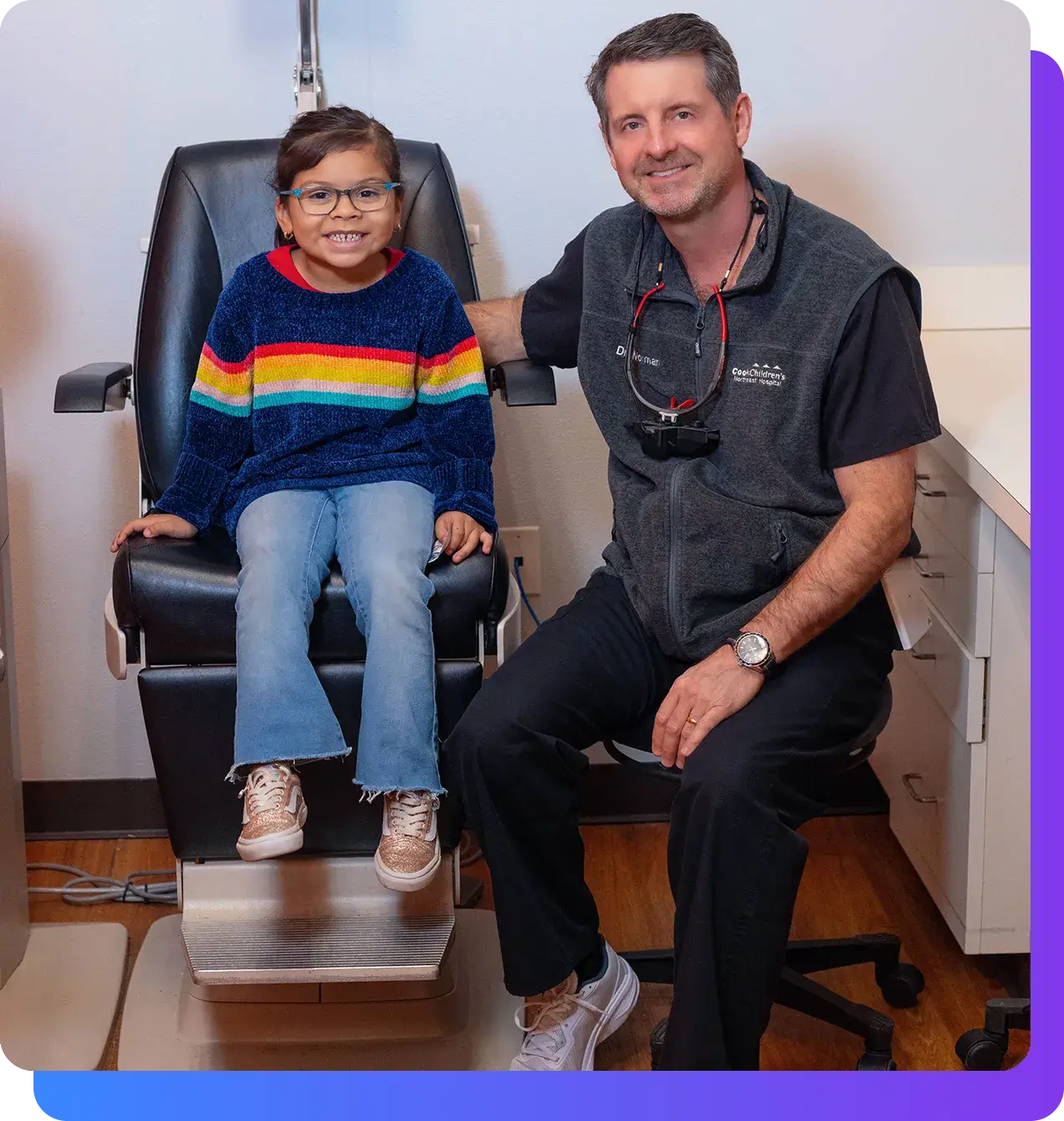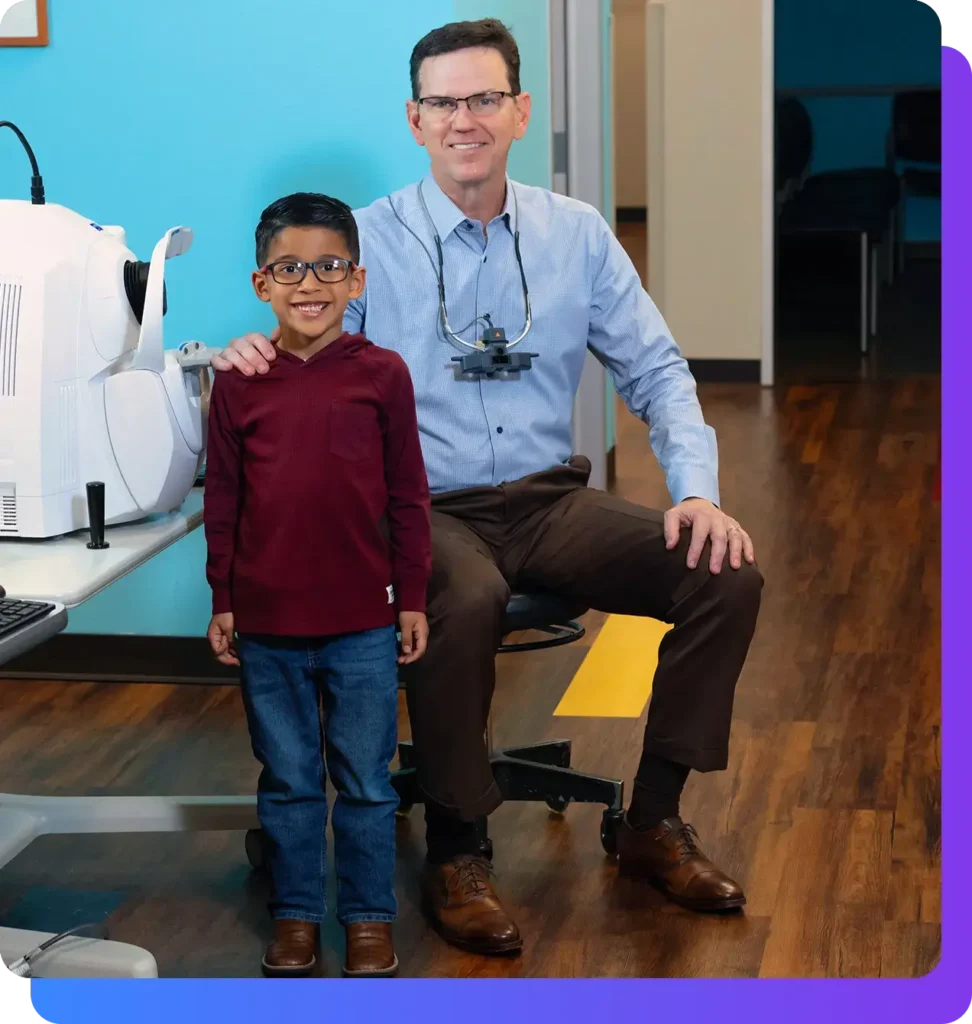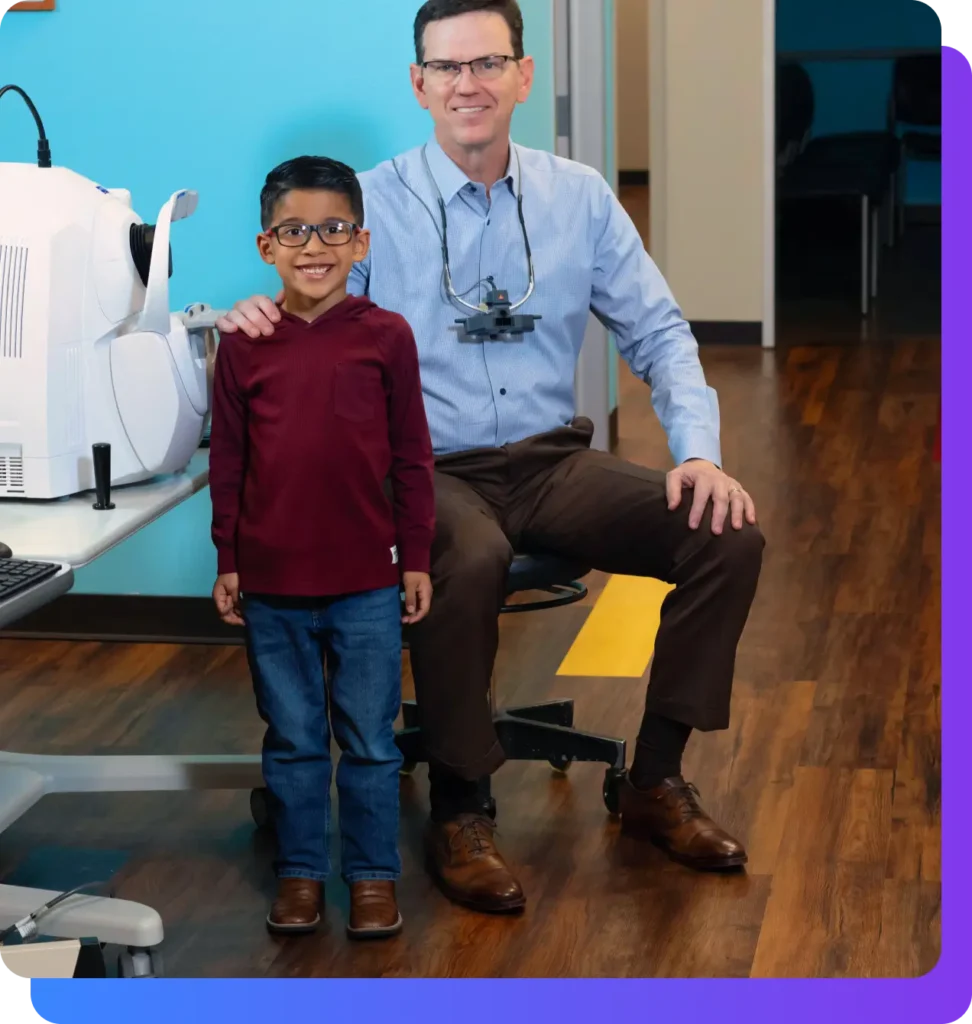Pediatric Uveitis
Specialists in North Texas
As a parent, discovering that your child may have pediatric uveitis can be a daunting experience, filled with worries and uncertainties. The thought of your child suffering from an eye condition, which might be as unfamiliar as it is serious, can be overwhelming. You might be grappling with questions about what this means for your child’s vision, their daily life, and their future.
Treating Pediatric Uveitis: Our Supportive Approach
At Pediatric Eye Specialists, we understand these fears and are committed to not only alleviating them but also providing the highest standard of care for your child. Our team, comprised of experts in pediatric ophthalmology, is here to guide you through every step of the process, offering a blend of advanced medical expertise and a compassionate approach. We believe in empowering you with knowledge and providing individualized care that addresses the unique needs of your child. Our dedication goes beyond medical treatment, as we aim to support you and your child through this journey, ensuring your child sees their brightest future.

The Basics: What is Pediatric Uveitis?
Pediatric uveitis is an inflammatory eye condition affecting the uvea, the middle layer of the eye, in children. This inflammation can cause redness, pain, blurred vision, and light sensitivity, potentially affecting one or both eyes. Uveitis in children can be associated with autoimmune disorders, infections, or can be idiopathic, meaning the exact cause is unknown. The condition can range from mild to severe and, if left untreated, may lead to complications like glaucoma, cataracts, or even vision loss. Early diagnosis and treatment are essential for managing symptoms and preventing long-term eye damage, helping to preserve a child’s vision and overall eye health.
Why Pediatric Eye Specialists for Pediatric Uveitis
The Most Experienced Team in North Texas
With over sixty-five years of collective pediatric ophthalmology expertise, we offer your child unparalleled collaborative care.
Five Convenient Locations
Easily accessible care with offices in Fort Worth, Denton, Keller, Mansfield, and Prosper.
Unrushed, Clear Communication
We take the time to discuss your child's diagnosis and treatment, ensuring all your questions are answered to ease your concerns.
Affiliated with Cook Children’s Hospital
Our partnership with Cook Children’s Hospital means if your child needs surgery, imaging, or other specialists, they will be treated in one of the nation’s leading pediatric hospitals.
Specialized Expertise
Our expertise means that more optometrists, doctors, and specialists refer their pediatric eye patients to Pediatric Eye Specialists than any other pediatric eye practice in North Texas.
Child and Family Focused
Kids love us, and we love kids! We provide a caring environment for your child and your family.
Advanced Diagnostic Technology
We have the most comprehensive pediatric diagnostic suite in North Texas, allowing for precise diagnosis and highly personalized treatment plans.
Every Child Needs Access to Expert Eye Care
Championing the right to sight, we help navigate insurance, cash pay, and Medicaid options to make superior eye care feasible for all children regardless of their socioeconomic status.

Benefits of Treating Pediatric Uveitis
Treating pediatric uveitis promptly and effectively is crucial for preserving your child’s vision and preventing long-term complications.
Success You Can Expect for Your Child
Improved Vision and Eye Health
Early intervention for pediatric uveitis significantly improves visual outcomes. Our dedicated approach helps preserve and enhance your child's vision, ensuring they experience the world in all its vibrancy.
Prevention of Complications
Treatment reduces the risk of severe associated eye conditions such as glaucoma, cataracts, and vision loss. Our comprehensive care model is designed to catch and address complications before they escalate, safeguarding your child's eye health.
Access to Cutting-Edge Treatments
Our specialists stay abreast of the latest advancements in uveitis treatment. From innovative drug therapies to breakthrough surgical techniques, we ensure your child benefits from the most effective, current treatment methods available.
Comprehensive, Ongoing Care
Pediatric uveitis requires consistent, long-term management. We provide ongoing care and regular follow-ups, adapting treatment plans as your child grows and their needs evolve.
Support for Overall Development
Recognizing that vision health impacts a child's overall development, our treatments and therapies are tailored to support their holistic growth. Maintaining good vision can aid in educational and social skills development.
Enhanced Quality of Life
Our goal is to improve not just vision but the overall quality of life for your child. Effective treatment can enhance daily functioning, social interactions, and participation in activities, allowing your child to live a fuller, more engaged life.
Long-Term Vision Protection
Protecting your child's vision in the long term is the ultimate goal. We implement proactive strategies to manage pediatric uveitis effectively, aiming to preserve and enhance your child's vision well into the future.
Real Stories,
Real Smiles.
“They were very good with my nonverbal toddler. It was the best doctor visit experience we have had yet. They were awesome, caring, and quick!.”

Amy Glover
Parent of Patient
“Today, Dr. Packwood saved my youngest from a life of blindness and worked a miracle for my family. I cannot express enough gratitude and thanks for their skillful surgery and expertise. 10 of 10 highly recommend.”

Atticus Lee
Parent of Patient
“The staff here is so amazing with my son. We had such a wonderful experience both at the office and for his surgery! I highly recommend Pediatric Eye Specialists!!!!“

Gianna Stutzman
Parent of Patient
“We are so grateful for the genuine care that Dr. Duff provided for our son Lorenzo, which prevented him from going blind! She is truly a gift to the community.“

JS Cocjin
Parent of Patient
“Professional, compassionate, kind and friendly. They took great care of my preemie baby from Day 1 of ROP. Very happy with how my daughter is progressing and has healthy eyes now.”

Suresh K.C.
Parent of Patient
“We’ve seen Dr. Hunt for the past 6 years since my daughter was 9 days old. We have multiple appointments each year and even eye surgery when she was 1. Our experience here has been fantastic every time and we highly recommend this group!.”

Mandy Edmondson
Parent of Patient
“Dr. Norman has always been very attentive and thorough with my daughter, who has Type 1 Diabetes. The staff are warm and always do their best to be accommodating. I highly recommend Dr. Norman.”

Tricia Moon
Parent of Patient
“Absolutely recommend! All around great experience! They made my son feel comfortable during the visit. Treatment was explained, and I walked out with no questions. I loved it. “

Cynthia Valero
Parent of Patient
“Great staff, great doctors; they know how to help ease kids’ fears and provide excellent service. Had to get my little one in same day for an eye injury, and they found a way to make it happen. Would 100% recommend.“

Kris K
Parent of Patient
Start your child’s journey to better vision today.
Embrace a future of clearer vision and confidence for your child. Contact us now to book your consultation at any of our convenient locations across the Metroplex.
Click to Explore Pediatric Uveitis
Causes of Pediatric Uveitis: Understanding the Underlying Factors
Pediatric uveitis is a complex condition with various underlying causes. By exploring these factors, Pediatric Eye Specialists can tailor treatment to each child’s specific needs. Here are the key contributors:
Genetic Factors
Certain genetic predispositions can increase the risk of developing uveitis. Children with a family history of autoimmune diseases or specific genetic markers may be more susceptible to this condition.
Autoimmune Disorders
Autoimmune conditions, where the body’s immune system mistakenly attacks its tissues, are a common cause of uveitis in children. Juvenile idiopathic arthritis (JIA) is one of the most frequent autoimmune diseases associated with uveitis. Uveitis associated with JIA often has no visible symptoms so regular appointments with your child’s ophthalmologist are important to detect signs of uveitis.
Environmental Triggers
Exposure to certain environmental factors, including infections or toxins, can trigger uveitis. Bacterial, viral, or parasitic infections might initiate an inflammatory response leading to uveitis.
Associated Systemic Diseases
Uveitis in children can be a symptom of broader systemic diseases. Sarcoidosis, Behçet’s disease, and inflammatory bowel diseases like Crohn’s disease and ulcerative colitis are known to have ocular manifestations including uveitis.
Idiopathic Causes
In some cases, the exact cause of uveitis remains unknown (idiopathic). These instances require careful monitoring and a broad approach to treatment and management.
Injury-Induced Uveitis
Trauma to the eye can sometimes lead to uveitis. The body’s response to eye injuries might involve inflammation, which can evolve into uveitis if not properly managed.
Infectious Causes
Infections such as toxoplasmosis, herpes viruses, and tuberculosis can lead to the development of uveitis in children. These infections cause inflammation in the uveal tract, leading to uveitis.
Drug-Induced Uveitis
Certain medications can induce uveitis as a side effect. This type of uveitis typically resolves once the medication is discontinued.
Understanding these causative factors allows Pediatric Eye Specialists to formulate an effective treatment plan and address not just the symptoms of uveitis but also its root causes, ensuring a comprehensive approach to your child’s eye health.
Understanding these causes is vital for Pediatric Eye Specialists in diagnosing and formulating an effective treatment plan for uveitis.
Signs and Symptoms of Pediatric Uveitis: Key Indicators for Early Detection
Detecting pediatric uveitis early is vital for effective treatment and preventing complications. Parents should be aware of the following signs and symptoms to ensure timely medical attention:
Eye Redness
One of the most noticeable signs of uveitis is redness in the eye, which can be more pronounced around the iris (colored area of eye surrounding the pupil).
Pain and Discomfort
Children may complain of eye pain or discomfort, which can vary from a dull ache to sharp pain, often worsening with exposure to bright light.
Blurred Vision
Uveitis can cause vision to become blurry or cloudy, impacting the child’s ability to see clearly.
Photophobia
Increased sensitivity to light, or photophobia, is a common symptom that can cause discomfort in normal lighting conditions.
Floating Spots or Shapes
The presence of floating spots or shapes in the child’s vision, known as floaters, can be an indicator of uveitis.
Eye Watering or Tearing
Excessive tearing or watering of the eye can occur as the body’s response to irritation and inflammation.
Swelling
Swelling or puffiness around the eye or eyelid may be noticeable, indicating inflammation. This is rare in pediatric uveitis but can happen.
Headaches
Uveitis can be accompanied by headaches, particularly if the inflammation is severe or persistent.
Altered Pupil Shape
In some cases, uveitis can cause the pupil to change shape, appearing irregular or oval instead of round.
Decreased Vision
A noticeable decrease in vision, such as difficulty reading or seeing objects at a distance, can be a sign of advanced uveitis.
Change in Eye Color
Chronic uveitis can sometimes lead to a subtle change in the color of the affected eye, usually making it slightly darker.
Unequal Pupil Sizes
A difference in pupil sizes between the two eyes, known as anisocoria, can be a symptom of uveitis.
Have Concerns?
Recognizing these signs and symptoms is critical for early intervention. If your child exhibits any of these indicators, it is important to schedule an appointment with Pediatric Eye Specialists for a comprehensive evaluation and appropriate treatment. Early detection and management are key to preventing vision impairment and ensuring the best possible outcomes for your child’s eye health.
Diagnosing Pediatric Uveitis: Comprehensive Diagnostic Process
Accurately diagnosing pediatric uveitis involves a detailed and methodical approach. At Pediatric Eye Specialists, we employ a range of clinical exams and imaging techniques to ensure a precise diagnosis:
Detailed Medical History
The diagnostic process begins with a thorough review of the child’s medical history, including any previous eye issues, systemic illnesses, family history of autoimmune diseases, and symptoms experienced.
Ophthalmologic Examination
A comprehensive eye exam is conducted, focusing on signs of inflammation. This includes checking for redness, pain, photophobia, and vision changes. Special attention is given to the anterior and posterior segments of the eye.
Slit-Lamp Examination
Using a slit lamp, an instrument that allows a magnified view of the eye, the doctor examines the front part of the eye, including the cornea, iris, and lens, for signs of inflammation and other abnormalities.
Fundus Examination
This examination involves looking at the back of the eye, including the retina and optic nerve, to check for any signs of inflammation or damage.
Visual Acuity Test
Assessing the child’s ability to read letters or symbols on an eye chart helps determine any impact of uveitis on vision.
Intraocular Pressure Measurement
Measuring the pressure inside the eye is crucial as uveitis can lead to increased intraocular pressure, posing a risk for glaucoma.
Laboratory Tests
Blood tests may be conducted to check for markers of autoimmune diseases, infections, or inflammation that could be associated with uveitis.
Imaging Studies
Depending on the case, imaging techniques like Optical Coherence Tomography (OCT), Fluorescein Angiography, or B-Scan Ultrasonography may be used to visualize the structures of the eye in greater detail and assess the extent of inflammation.
Consultation with Other Specialists
If an underlying systemic condition is suspected, consultations with pediatric rheumatologists or infectious disease specialists may be necessary.
Regular Follow-ups
Ongoing monitoring is essential for assessing the effectiveness of treatment and detecting any changes in the condition.
Our diagnostic approach at Pediatric Eye Specialists is thorough and patient-centered, ensuring that every aspect of uveitis is carefully evaluated. We understand the importance of an accurate diagnosis in developing an effective treatment plan and are committed to providing the highest standard of care for your child.
Treatments for Pediatric Uveitis: Comprehensive and Multifaceted Approaches
Treating pediatric uveitis at Pediatric Eye Specialists involves a combination of medical, surgical, and integrative methods, each tailored to the specific needs of the child. Our focus is on reducing inflammation, relieving symptoms, and preventing vision loss.
Topical Corticosteroids
Topical corticosteroids are often the initial treatment strategy for pediatric uveitis, aimed at reducing eye inflammation effectively.
Systemic Corticosteroids
In more severe cases of uveitis, systemic corticosteroids are administered orally or intravenously to manage inflammation and symptoms.
Immunomodulatory Therapy (IMT)
IMT, including drugs like methotrexate or mycophenolate mofetil, is used for cases that are resistant to steroids or to reduce the side effects associated with long-term steroid use.
Biologic Agents
Biologic medications, such as adalimumab or infliximab, specifically target immune system pathways and are employed in treating refractory uveitis.
Vitrectomy
Vitrectomy, a surgical intervention, is necessary in certain uveitis complications, such as vitreous hemorrhage or retinal detachment.
Cataract Surgery
Cataract formation can be accelerated by uveitis, making cataract surgery a frequently required procedure for affected children.
Regular Eye Examinations
Regular eye exams are crucial in monitoring the progression of uveitis and making timely adjustments to the treatment plan.
Diet and Lifestyle Changes
Advising on diet and lifestyle modifications is a part of integrative treatment, aiming to support overall health and possibly reduce inflammation.
Physical Therapy or Occupational Therapy
For children with juvenile idiopathic arthritis and related joint issues, physical or occupational therapy plays an essential role in the comprehensive treatment plan.
Coordinated Care with Other Specialists
Pediatric Eye Specialists collaborates with pediatric rheumatologists and other specialists to provide a multidisciplinary approach to uveitis care.
At Pediatric Eye Specialists, we understand that every case of pediatric uveitis is unique. Our team of experts is dedicated to providing personalized care, utilizing a range of treatment options to ensure the best possible outcomes for our young patients.
Our commitment at Pediatric Eye Specialists is to provide your child with the highest standard of care, combining medical expertise with compassion and understanding.
Expected Outcome Prognosis After Treatment
Visual Improvement
Treatment of pediatric uveitis can leads to significant visual improvement or preservation of good vision, enhancing the child’s ability to see clearly and participate in daily activities.
Symptom Management
Effective management of uveitis symptoms, including pain and discomfort, is a common outcome, contributing to a better quality of life for the child.
Reduction in Complication Risks
Timely and appropriate treatment substantially reduces the risk of complications such as cataracts, glaucoma, or vision loss.
Long-term Eye Health
With ongoing care and monitoring, many children with uveitis maintain good eye health over the long term, preventing severe visual impairment.
Need for Continuous Management
While some cases of uveitis can be resolved, others may require ongoing treatment and monitoring to manage the condition effectively.
Secure a Bright Future: Schedule Your Child's Uveitis Consultation Today
Navigating a diagnosis of pediatric uveitis can be overwhelming, but at Pediatric Eye Specialists, you have a partner every step of the way. Schedule a consultation with our experts today to secure the best possible care for your child. Let us help you provide your child with the brightest future possible, starting with their eye health.

Start your child’s journey to better vision today.
Embrace a future of clearer vision and confidence for your child. Contact us now to book your consultation at any of our convenient locations across the Metroplex.
If my child has uveitis in one eye, what are the chances it will develop in the other eye?
Uveitis can affect one or both eyes. If it is related to a systemic issue, it is more likely to be present in both eyes, but each case is different. It does not spread from one eye to the other like an infection. Regular monitoring and early treatment are key to managing the condition effectively and reducing the risk of it affecting both eyes.
What are some comfort measures or home care tips I can use to help my child manage the discomfort caused by uveitis?
To alleviate discomfort, ensure your child avoids bright light and uses sunglasses if needed. Using a cool compress can also provide relief. Always follow the medication regimen prescribed by your child’s ophthalmologist for effective management of symptoms.
Can making changes to my child’s diet help in controlling the symptoms or progression of uveitis?
While diet alone cannot cure uveitis, a balanced diet rich in anti-inflammatory foods can support overall eye health. Foods high in omega-3 fatty acids, like fish, and those rich in antioxidants, like fruits and vegetables, are beneficial. Always consult your child’s healthcare provider for personalized advice.
What are the possible side effects of the drugs prescribed for my child’s uveitis?
The side effects depend on the specific medication prescribed. Common ones for uveitis treatments include increased appetite, mood changes, stomach upset, and increased susceptibility to infections. Your child’s eye specialist will discuss these in detail and monitor for any adverse effects.
Will the treatment for uveitis limit my child’s participation in school and physical activities, and if so, how can we manage these limitations?
Uveitis treatment should not significantly limit your child’s school attendance or physical activity. In some cases, adjustments might be necessary to manage discomfort or light sensitivity. Ongoing communication with your child’s school and healthcare provider will help in making necessary accommodations.
How does juvenile arthritis affect the risk of developing pediatric uveitis, and what are the treatment options?
Juvenile arthritis has a correlation with pediatric uveitis. Treatment options may include immunosuppressive drugs like cyclophosphamide and biologics like rituximab to control inflammation. Those diagnosed with JIA should have regular eye exams to check for uveitis as often in these cases there are no noticeable symptoms of the uveitis in its early stages.
What is acute retinal necrosis, and how is it related to pediatric uveitis?
Acute retinal necrosis is a severe viral infection often caused by the herpes simplex, varicella zoster, or cytomegalovirus, leading to retinal inflammation and is associated with uveitis. It requires prompt antiviral treatment and, in some cases, may necessitate the use of immunosuppressive drugs to manage inflammation. Thankfully this condition is very rare.
My child has been diagnosed with intermediate uveitis; can this lead to other complications like secondary glaucoma?
Intermediate uveitis targets the vitreous body and peripheral retina and can indeed lead to complications such as secondary glaucoma. Close monitoring and treatment, which may include corticosteroids or immunomodulatory agents like mycophenolic acid, are essential to manage uveitis and prevent such complications.
Can uveitis cause problems like macular edema, and how does it affect visual perception?
Yes, uveitis can cause macular edema, which is the swelling of the central portion of the retina (macula) and can significantly affect visual perception, leading to blurry or distorted vision. Medications like azathioprine and cyclosporin are often used to treat the inflammation that leads to macular edema.
What are the signs of vasculitis in the context of pediatric uveitis, and how does it impact the eye?
Vasculitis in uveitis can present as retinal vasculitis, evidenced by inflammation of the blood vessels in the retina, which may lead to edema and granuloma formation. It can severely impact the eye, leading to vision loss if not treated with appropriate anti-inflammatory and immunosuppressive therapies.
Are there any specific types of cancer that can mimic pediatric uveitis symptoms like granuloma or keratic precipitates?
Certain neoplasms or cancers can present with eye inflammation that mimic uveitis, leading to granuloma formation or keratic precipitates. Lymphoma, for example, can present with ocular symptoms similar to uveitis and requires differential diagnosis to rule out other causes.
Can pediatric uveitis be asymptomatic, and how can it be detected early to prevent conditions like amblyopia?
Pediatric uveitis can sometimes be asymptomatic, particularly in its early stages. Regular eye examinations are crucial, as they can detect early signs like keratic precipitates or edema even before symptoms appear, thus preventing complications such as amblyopia, which can result from untreated inflammation.
What viruses are known to cause pediatric uveitis?
Viruses that can cause pediatric uveitis include herpes simplex virus, cytomegalovirus, and varicella zoster virus, which also causes chickenpox. Signs of a viral infection can include acute retinal necrosis, optic neuritis, and ocular hypotony. Antiviral medication and sometimes immunotherapy are used to treat these infections.
In cases of pediatric uveitis associated with Blau syndrome, how are monoclonal antibodies and interferon used in treatment, and what are the risks associated with these therapies?
For Blau syndrome, which is a genetic inflammatory condition, treatment may include monoclonal antibodies like adalimumab to target specific inflammatory pathways or interferon to modulate the immune response. These treatments carry risks such as increased infection rates, which must be carefully balanced against their benefits.
What is panuveitis and how does it affect the eye?
Panuveitis is a severe form of uveitis that affects all layers of the uvea, including the iris, ciliary body, and choroid. It can lead to complications like chorioretinitis, where the retina and choroid become inflamed, creating lesions that can severely affect vision.
Can pediatric uveitis lead to conditions like and band keratopathy?
Yes, pediatric uveitis can lead to corneal conditions such band keratopathy, where calcium deposits form on the cornea, potentially affecting the child’s vision.
How does a past chickenpox infection relate to pediatric uveitis, and what are the treatment options?
A past chickenpox infection, caused by the varicella zoster virus, can increase the risk of uveitis in children though it is rare for children to have uveitis associated with varicella infection. If uveitis occurs, treatment may include antiviral drugs to manage the viral infection and anti-inflammatory medications like topical steroids to reduce ocular inflammation.
What role do tumor necrosis factor (TNF) inhibitors and monoclonal antibodies play in treating pediatric uveitis, and what are potential side effects?
TNF inhibitors and monoclonal antibodies, such as those targeting specific immune cells, are used to treat severe or refractory pediatric uveitis by reducing inflammation. However, they can increase the risk of infections due to their immunosuppressive effects.
How is ocular hypertension associated with pediatric uveitis managed, and can it lead to glaucoma?
Ocular hypertension in pediatric uveitis is managed with medications to lower eye pressure, as it can lead to glaucoma if left untreated. These treatments are crucial to prevent vision loss and preserve the health of the optic disc.
Are adolescents with pediatric uveitis at risk for developing interstitial nephritis, and how does this affect their overall health?
Yes, adolescents with pediatric uveitis, particularly those with systemic conditions like sarcoidosis, may be at risk for interstitial nephritis, an inflammation of the kidneys that can affect renal function and overall health.
What types of eye surgery might be needed for children with lesions caused by pediatric uveitis, and what precautions are taken?
Children with severe uveitis may require eye surgeries like vitrectomy to remove vitreous opacities or repair retinal detachment. Surgeries are performed with caution, considering the risks and the presence of any underlying conditions like juvenile xanthogranuloma or systemic arthritis (arthralgia).
Is Lyme disease a contributing factor to pediatric uveitis, and how is it confirmed through clinical diagnosis?
Lyme disease, caused by bacteria transmitted through tick bites, can be a contributing factor to pediatric uveitis. Diagnosis is confirmed through blood tests, and treatment involves the use of antibiotics and anti-inflammatory medications, including TNF inhibitors if necessary.
What is panuveitis, and how does it affect adolescents?
Panuveitis is a severe form of uveitis that involves all layers of the uveal tract: the iris, ciliary body, and choroid. In adolescents, this condition can lead to significant visual impairment and may manifest as redness, pain, and vision changes. It’s often associated with systemic conditions that can present with skin lesions or scars, and may require tests for antinuclear antibodies and angiotensin-converting enzymes to determine the etiology. The epidemiology of panuveitis varies, but it’s crucial to seek prompt medical attention, including possible injections or enzyme treatments, if this skin condition or related symptoms are observed.
Can pediatric uveitis lead to weight gain or other systemic issues?
While pediatric uveitis itself is not directly associated with weight gain, some treatments, particularly corticosteroids when used systemically, can potentially lead to increased appetite and weight gain. These medications can also increase the risk factor for developing osteoporosis, especially if used over a prolonged period. It’s crucial to monitor a child’s health closely and manage any side effects in consultation with a healthcare provider.
How does pediatric uveitis affect the anterior segment of the eyeball?
Inflammation in pediatric uveitis primarily affects the anterior segment of the eyeball, which includes the iris and adjacent structures. This can lead to symptoms like pain, redness, blurred vision, and the formation of neovascularization—new, abnormal blood capillaries. Regular use of prescribed eye drops, can help manage the condition and prevent complications like scarring.
What are the risks of developing complications like peptic ulcer disease from uveitis medications?
Certain medications used in treating pediatric uveitis, such as immunosuppressive drugs like tocilizumab, can increase the risk of peptic ulcer disease. It is essential to discuss any concerns about medication side effects with your child’s doctor.
How does remission work in pediatric uveitis, and how is it achieved?
Remission in pediatric uveitis refers to a period when the symptoms subside, and inflammation is controlled, often as a result of effective treatment. Achieving remission typically involves a tailored combination of medications that may include immunosuppressants and biological agents to maintain ocular and systemic immunocompetence. Regular monitoring and adjustments to the treatment regimen are critical to sustaining remission.